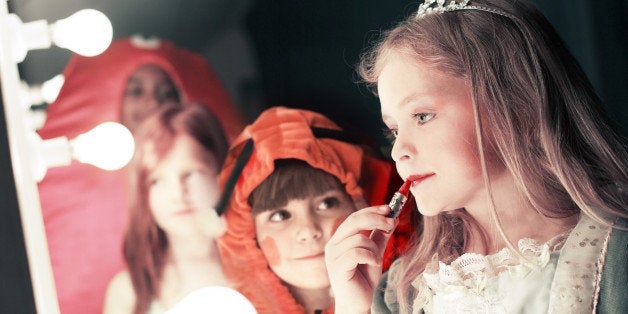
"You should've seen our living room on Christmas afternoon -- it was like Santa's bag of toys exploded pink, glittery fairy dust all over the place. How on earth did our daughters end up to be all-princess, all the time?!"
For at least two generations, progressive parents have encouraged daughters to cast off restrictive gender roles that equate "girl" with "femininity." We've told them, "You can play with trucks, you can be smart, assertive and powerful, and you can grow up to be President someday."
Yet so many of us are left scratching our heads as our daughters somehow still end up dressed as princesses, narrowing their own gender expression into a girlygirl-ness that seems positively retro in 2015. Despite our best efforts, princesses aren't going anywhere, and neither is girlygirl culture. How do we help our daughters value all parts of themselves, including the ones that conform to feminine gender roles that make us uncomfortable?
At the very moment princesses are hotter than ever, there's a gender revolution underway in the culture. The new transgender frontier doesn't just add a third gender category. It has shattered the notion that gender is limited to two categories of male and female, and instead views gender as a spectrum.
That spectrum isn't just about how girly or boyish we look, but how we think about our identities. This radical new frontier moves from telling our daughters, 'You can express your gender any way you want' to now telling them, 'You can define your gender any way you want.'
At younger and younger ages, kids are learning that gender isn't simply boy/girl anymore. The gender revolution is everywhere: in the Caitlyn Jenner media frenzy, on gender-fluid rock star Miley Cyrus's Instagram, in the over 50 gender identities you can choose from on Facebook or in our daily lives with friends, teachers, aunts, uncles or parents who are trans*.
The gender revolution offers an opportunity for every parent to teach our kids that there's not just a spectrum of masculinity to femininity out there in the world -- but inside each of us as well. At the very least, teaching our kids about gender expansiveness will help them embrace all parts of themselves; at most, it will prevent the depressive isolation that leads to high suicide rates among transgender youth.
So how do we translate the lessons of Miley Cyrus, Caitlyn Jenner and countless transgender pioneers before them into progressive parenting practice?
Start to notice what I call the genderfication of the world -- how pervasively our culture divides the world first and foremost by gender, into a binary of boy/girl, man/woman. Start to notice how many times a day you catch yourself looking at the world that way -- registering each person's gender ahead of all other identifiers, assessing how they're dressed or acting based on gendered expectations -- and how often you communicate that bifurcation of the world to your kids. When we wonder how a 3 year old knows so clearly how girls are different from boys, we need to look at how we express that 'girl is x, and boy is y' (so to speak).
Then help your kids to notice how silly the genderfication of the world is -- as you walk down the aisle in the supermarket or at WalMart; as you watch TV commercials or sitcoms; or as you listen to the lyrics of songs. When you're choosing birthday gifts for their friends, detour from your kneejerk first question of whether it's a birthday boy or birthday girl; instead, try thinking out loud about the kind of person the kid is and what activities they enjoy.
Explain to your child, in a matter of fact way and from a young age, that:
•there are so-called 'boyish' parts and 'girlish' parts to each and every one of us, and give concrete examples of that in the adults they know
•you love all the parts of them, the boyish parts and the girlish parts, and want to help all parts of them grow
•while most of us look on the outside just like we feel on the inside, some people look like girls on the outside but feel like boys on the inside and some people look like boys on the outside but feel like girls on the inside
•some people don't feel like boy OR girl, but something in between, something else or BOTH boy and girl
•people are always changing, so how she might think of herself today might not be the same as she thinks of herself a year from now
•even if we feel uncomfortable or confused when we see people who are clearly gender-nonconforming or trans*, we need to remember that they are normal human beings worthy of our respect
It's important that they receive these messages from both the men and the women in their lives. If your daughter has a mom and a dad, make sure it's not only Mom who talks to her about this.
Give them language that expands the gender binary beyond boy/girl to all sorts of new identities they might hear about from their friends or on social media -- transgender/bigender/genderqueer/gender-fluid/gender-neutral.
Cleanse your own language of attributing masculinity or femininity to particular qualities or characteristics. Maybe "handsome" doesn't only belong to males and "pretty" to females. Likewise, "rough and tumble," "strong and silent," "dainty," "flirty," . . . and "boys will be boys."
Look in the mirror: how much do you truly embrace your female masculinity or male femininity? All of us are wearing our genders -- in our hair, the bags we carry, our cell phone cases, our running shoe colors, our watches. How lightly or heavily, restrictively or expansively do you wear your gender? If you make gender-based choices on what to wear, carry, display or drive -- either toward or away from gender conformity -- consider verbalizing your decision-making to your kids. Then, they can understand that gender expression is a choice.
Our kids are watching us -- what are we showing them about how we present our own genders? About what we value in ourselves? In our spouses/partners? In them?
